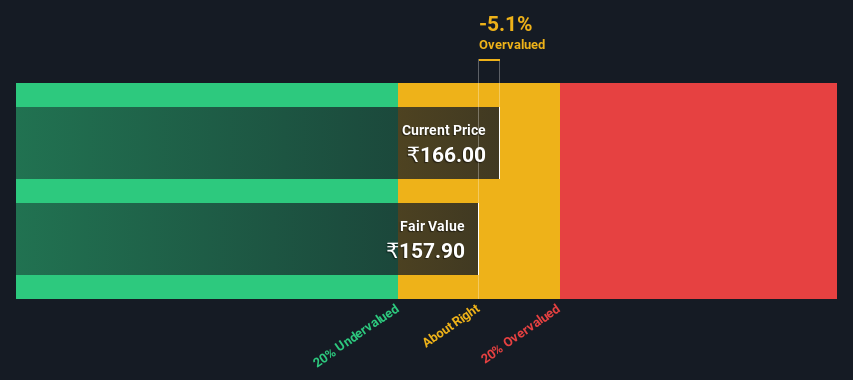- India
- /
- Hospitality
- /
- NSEI:ASIANHOTNR
A Look At The Fair Value Of Asian Hotels (North) Limited (NSE:ASIANHOTNR)

Key Insights
- The projected fair value for Asian Hotels (North) is ₹158 based on 2 Stage Free Cash Flow to Equity
- Asian Hotels (North)'s ₹166 share price indicates it is trading at similar levels as its fair value estimate
- When compared to theindustry average discount of -407%, Asian Hotels (North)'s competitors seem to be trading at a greater premium to fair value
Does the November share price for Asian Hotels (North) Limited (NSE:ASIANHOTNR) reflect what it's really worth? Today, we will estimate the stock's intrinsic value by estimating the company's future cash flows and discounting them to their present value. Our analysis will employ the Discounted Cash Flow (DCF) model. It may sound complicated, but actually it is quite simple!
We would caution that there are many ways of valuing a company and, like the DCF, each technique has advantages and disadvantages in certain scenarios. If you want to learn more about discounted cash flow, the rationale behind this calculation can be read in detail in the Simply Wall St analysis model.
See our latest analysis for Asian Hotels (North)
What's The Estimated Valuation?
We use what is known as a 2-stage model, which simply means we have two different periods of growth rates for the company's cash flows. Generally the first stage is higher growth, and the second stage is a lower growth phase. In the first stage we need to estimate the cash flows to the business over the next ten years. Seeing as no analyst estimates of free cash flow are available to us, we have extrapolate the previous free cash flow (FCF) from the company's last reported value. We assume companies with shrinking free cash flow will slow their rate of shrinkage, and that companies with growing free cash flow will see their growth rate slow, over this period. We do this to reflect that growth tends to slow more in the early years than it does in later years.
Generally we assume that a dollar today is more valuable than a dollar in the future, and so the sum of these future cash flows is then discounted to today's value:
10-year free cash flow (FCF) estimate
| 2024 | 2025 | 2026 | 2027 | 2028 | 2029 | 2030 | 2031 | 2032 | 2033 | |
| Levered FCF (₹, Millions) | ₹468.4m | ₹522.0m | ₹574.4m | ₹626.4m | ₹678.8m | ₹732.3m | ₹787.5m | ₹845.1m | ₹905.5m | ₹969.2m |
| Growth Rate Estimate Source | Est @ 13.45% | Est @ 11.44% | Est @ 10.04% | Est @ 9.05% | Est @ 8.37% | Est @ 7.88% | Est @ 7.55% | Est @ 7.31% | Est @ 7.15% | Est @ 7.03% |
| Present Value (₹, Millions) Discounted @ 23% | ₹380 | ₹343 | ₹306 | ₹270 | ₹237 | ₹207 | ₹181 | ₹157 | ₹136 | ₹118 |
("Est" = FCF growth rate estimated by Simply Wall St)
Present Value of 10-year Cash Flow (PVCF) = ₹2.3b
We now need to calculate the Terminal Value, which accounts for all the future cash flows after this ten year period. The Gordon Growth formula is used to calculate Terminal Value at a future annual growth rate equal to the 5-year average of the 10-year government bond yield of 6.8%. We discount the terminal cash flows to today's value at a cost of equity of 23%.
Terminal Value (TV)= FCF2033 × (1 + g) ÷ (r – g) = ₹969m× (1 + 6.8%) ÷ (23%– 6.8%) = ₹6.2b
Present Value of Terminal Value (PVTV)= TV / (1 + r)10= ₹6.2b÷ ( 1 + 23%)10= ₹757m
The total value, or equity value, is then the sum of the present value of the future cash flows, which in this case is ₹3.1b. To get the intrinsic value per share, we divide this by the total number of shares outstanding. Compared to the current share price of ₹166, the company appears around fair value at the time of writing. Valuations are imprecise instruments though, rather like a telescope - move a few degrees and end up in a different galaxy. Do keep this in mind.

Important Assumptions
Now the most important inputs to a discounted cash flow are the discount rate, and of course, the actual cash flows. You don't have to agree with these inputs, I recommend redoing the calculations yourself and playing with them. The DCF also does not consider the possible cyclicality of an industry, or a company's future capital requirements, so it does not give a full picture of a company's potential performance. Given that we are looking at Asian Hotels (North) as potential shareholders, the cost of equity is used as the discount rate, rather than the cost of capital (or weighted average cost of capital, WACC) which accounts for debt. In this calculation we've used 23%, which is based on a levered beta of 2.000. Beta is a measure of a stock's volatility, compared to the market as a whole. We get our beta from the industry average beta of globally comparable companies, with an imposed limit between 0.8 and 2.0, which is a reasonable range for a stable business.
SWOT Analysis for Asian Hotels (North)
- No major strengths identified for ASIANHOTNR.
- Interest payments on debt are not well covered.
- Current share price is above our estimate of fair value.
- Has sufficient cash runway for more than 3 years based on current free cash flows.
- Lack of analyst coverage makes it difficult to determine ASIANHOTNR's earnings prospects.
- Debt is not well covered by operating cash flow.
Moving On:
Whilst important, the DCF calculation is only one of many factors that you need to assess for a company. DCF models are not the be-all and end-all of investment valuation. Rather it should be seen as a guide to "what assumptions need to be true for this stock to be under/overvalued?" If a company grows at a different rate, or if its cost of equity or risk free rate changes sharply, the output can look very different. For Asian Hotels (North), we've put together three fundamental items you should further examine:
- Risks: We feel that you should assess the 2 warning signs for Asian Hotels (North) (1 is significant!) we've flagged before making an investment in the company.
- Other High Quality Alternatives: Do you like a good all-rounder? Explore our interactive list of high quality stocks to get an idea of what else is out there you may be missing!
- Other Environmentally-Friendly Companies: Concerned about the environment and think consumers will buy eco-friendly products more and more? Browse through our interactive list of companies that are thinking about a greener future to discover some stocks you may not have thought of!
PS. Simply Wall St updates its DCF calculation for every Indian stock every day, so if you want to find the intrinsic value of any other stock just search here.
New: Manage All Your Stock Portfolios in One Place
We've created the ultimate portfolio companion for stock investors, and it's free.
• Connect an unlimited number of Portfolios and see your total in one currency
• Be alerted to new Warning Signs or Risks via email or mobile
• Track the Fair Value of your stocks
Have feedback on this article? Concerned about the content? Get in touch with us directly. Alternatively, email editorial-team (at) simplywallst.com.
This article by Simply Wall St is general in nature. We provide commentary based on historical data and analyst forecasts only using an unbiased methodology and our articles are not intended to be financial advice. It does not constitute a recommendation to buy or sell any stock, and does not take account of your objectives, or your financial situation. We aim to bring you long-term focused analysis driven by fundamental data. Note that our analysis may not factor in the latest price-sensitive company announcements or qualitative material. Simply Wall St has no position in any stocks mentioned.
About NSEI:ASIANHOTNR
Slightly overvalued with imperfect balance sheet.
Similar Companies
Market Insights
Community Narratives




